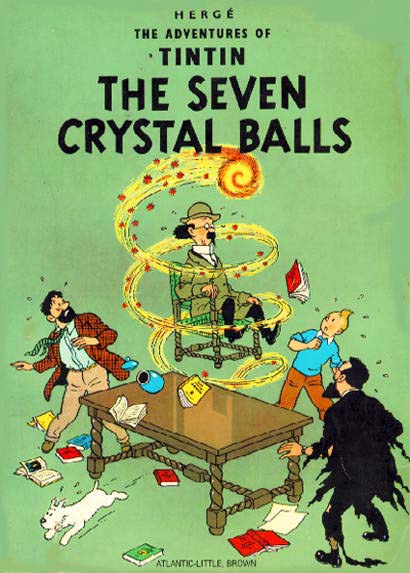- The Seven Crystal Balls
Graphicnovelbox| englishtitle=The Seven Crystal Balls
foreigntitle=Les Sept boules de cristal
caption=Cover of the English edition
publisher=Casterman
date=1948
series="The Adventures of Tintin (Les aventures de Tintin)"
origlanguage=French
origpublication="Le Soir "
origdate=December 16, 1943 - September 3, 1944
origisbn=2-203-00112-7
transtitle=The Seven Crystal Balls.
transpublisher=Methuen
transdate=1962
transseriestitle="The Adventures of Tintin "
transisbn=1-4052-0624-1
translator=Leslie Lonsdale-Cooper and Michael Turner
writers=Hergé
artists=Hergé
colorists=
previssue="Red Rackham's Treasure ", 1944
nextissue="Prisoners of the Sun ", 1949"The Seven Crystal Balls" ( _fr. Les Sept boules de cristal) is the thirteenth of "
The Adventures of Tintin ", a series of classic comic-strip albums, written and illustrated by Belgian writer and illustratorHergé , featuring young reporter Tintin as a hero.ynopsis
A mysterious illness is afflicting members of an archaeological expedition recently returned from the
Andes , where they had unearthed the tomb of theInca , Rascar Capac. One by one, the expedition members fall into a mysteriouscoma . The only clue is shards of crystal found near each victim, which are fragments of shattered crystal balls. Concerned, Tintin,Captain Haddock andProfessor Calculus go to stay with Calculus's old friend, and expedition member, the ebullient Professor Tarragon, who is keeping Rascar Capac's mummy in his house. But the mummy soon disappears when a lightning storm sends a ball of fire down the chimney, and, after each being visited in their nightmares by the mummy, the three wake to find Tarragon comatose, with the telltale shards of crystal by his bed.Tarragon later wakes up but screams about mysterious figures attacking him. Tintin later visits a hospital where all the other stricken explorers go through the same horrors at a precise time of day.
The plot thickens even further, however, when Calculus, taking a stroll around Professor Tarragon's house, discovers a striking gold bracelet, puts it on (remarking on how nicely it goes with his coat), and then mysteriously disappears. The bracelet had previously been worn by the now-vanished mummy.
While looking for Calculus, Tintin and the Captain are fired upon by an unseen gunman who escapes in a black car, having kidnapped Calculus. The alarm is raised and the police set up road blocks, but the kidnappers switch cars and slip through the net.
Tintin and Haddock pursue the abductors to
La Rochelle , where they discover that Calculus is on board a ship called the "Pachacamac", which is bound forPeru , and resolve to meet his ship there.The story is continued in "
Prisoners of the Sun ", the next volume in the series, although that did not appear until 1946, due to problems Hergé got into following the liberation of Belgium at the end ofWorld War II , when he and other members of the "Le Soir" were investigated for working for acollaborationist newspaper.Background
"The Seven Crystal Balls" was written during
World War II . WithBelgium under German occupation, Hergé decided to avoid the overt political content that he had included in previous Tintin stories, such as "The Blue Lotus ", "The Broken Ear " and "King Ottokar's Sceptre ".As the opening sequence of the book indicates, "The Seven Crystal Balls" and its theme of an ancient curse, was inspired by the
Curse of the Pharaohs , the speculation that members of theHoward Carter expedition, discoverers of the tomb ofTutankhamun , died in tragic and mysterious ways due to a curse.Publication history
The original serial version began regular publication in the Belgian newspaper "
Le Soir " on December 16, 1943. It was suspended on September 3, 1944, following the liberation ofBrussels , when Hergé and many of his colleagues had to answer for working for thecollaborationist newspaper.The strip ended with Tintin leaving the hospital after witnessing the mass panic attack of the explorers. He then walks through the street reading a newspaper when he collides with
General Alcazar . Alcazar tells him about the disappearance of his assistant Chiquito and how Chiquito is in fact a descendant of the Incas. "Tintin The Complete Companion" byMichael Farr , ISBN-10: 0719555221, ISBN-13: 978-0719555220]Publication resumed in the newly-launched "Tintin Magazine" in 1946, under the title "Le Temple du Soleil" (named "
Prisoners of the Sun " in English). It begins with Tintin on his way to Marlinspike where Haddock is in a state of depression over Calculus' disappearance. This and his sudden leap into action is said to be reflecting Hergé's mood at the time: his uncertain future due to the accusations of collaboration and the subsequent offer to help launch "Tintin Magazine". ] (The scene with Alcazar would be re-located to a city port with the General about to set off to South America himself).Connections with other Tintin books
Professor Paul Cantonneau, one of the scientists who is put to sleep by the Inca curse, had previously appeared as one of the expedition members in "
The Shooting Star " when he was on the receiving end of Tintin's suitcase, thrown down from the crow's nest by Philippulus the "prophet."General Alcazar of "The Broken Ear " andBianca Castafiore of "King Ottokar's Sceptre " also appear in the music-hall scenes. They were to guest-star in other adventures, including "Tintin and the Picaros " in which they both appear.pinoffs
A video game has been released based on this book and "
Prisoners of the Sun ".References
External links
* [http://www.tintinologist.org/guides/books/13seven.html The Seven Crystal Balls] at Tintinologist.org
Wikimedia Foundation. 2010.
